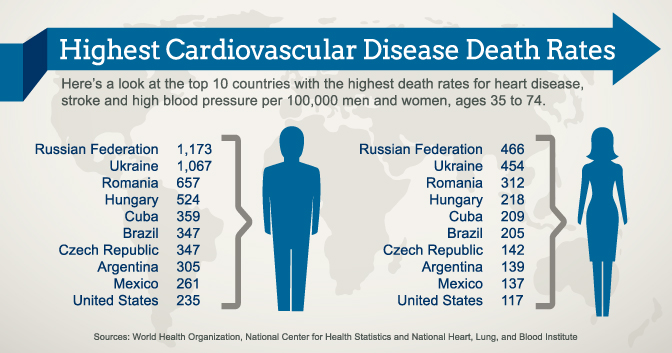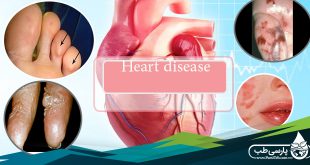Statistics of heart diseases or stroke in Canada are listed on this page are the most current available and are updated when new reports and studies are issued.
Statistics of heart disease or stroke in Canada
Remarkable progress has been made tackling cardiovascular disease in Canada over the past 60 years with death rates declining by more than 75 per cent. This has largely been due to research advances in surgical procedures, drug therapies and prevention efforts. Yet despite our progress, heart disease and stroke remain leading causes of death and hospitalization and the biggest driver of prescription drug use in Canada.
- An estimated 1.6 million Canadians are living with heart disease or the effects of a stroke.
- 1.3 million Canadians are living with heart disease.
- More than 400,000 Canadians are living with long-term stroke disability.
- In 2012, more than 66,000 Canadians died from heart disease or stroke. That’s one person every 7 minutes.
- In 2012, almost 14,000 Canadians died as the result of a heart attack.
- In 2012, more than 13,000 Canadians died as the result of a stroke.
- Each year more than 350,000 Canadians are hospitalized for heart disease or stroke.
- In 2011, more than 305,000 Canadians were hospitalized for heart disease.
- In 2011, more than 46,500 Canadians were hospitalized for stroke.
- Heart disease and stroke costs the Canadian economy more than $20.9 billion every year in physician services, hospital costs, lost wages and decreased productivity.
- By adopting healthy behaviours, you can delay the onset of heart disease or stroke by as much as 14 years.
- Up to 80% of premature heart disease and stroke is preventable by adopting healthy behaviours.

Important causes of heart disease or stroke
Children and Youth
Overweight and obesity
- 31% of Canadian children and youth aged 5 to 17, an estimated 1.6 million, are overweight or obese.
- Childhood overweight and obesity may result in premature onset of heart disease and stroke risk factors such as hypertension.
Vegetables and fruit
- Not eating enough vegetables and fruit is a major risk factors for heart disease and stroke; yet only 45% of children aged 12 to 19 eat at least 5 servings (the minimum recommended) of fruits and vegetables daily.
Tobacco and smoking
- 2% of children in grades 6-9 smoke and 7.8% of those in grades 10-12 smoke.
- On average, smokers smoke their first whole cigarette at the age of 16, and start smoking regularly by 18 years of age.
- There is no safe level of exposure to tobacco smoke. Any exposure to tobacco smoke – even an occasional cigarette or exposure to secondhand smoke – is harmful.
Physical activity
- Only 7% of Canadian children and youth accumulate at least 60 minutes of moderate- to vigorous-intensity physical activity at least 6 days a week, girls being significantly less active than boys.
- On average, children aged 6 to 17 spend nine hours a day sedentary.
- Accumulating at least 60 minutes of moderate- to vigorous-intensity physical activity every day contributes to many health benefits including improved cholesterol levels and blood pressure, cardiorespiratory fitness, academic achievement and improved mental health.
Marketing to kids
- Marketing is associated with increased consumption of fast foods, as well as unhealthy food and beverages containing high levels of fat, sodium and sugars.
- The majority of marketed food and beverage products (as much as 90%) are high in salt, fat, sugar or calories.
- Food and beverage marketing greatly influences children’s food preferences, purchase requests and choices.
- Children spend up to 11 hours per day in front of screens including computers, tablets, phones and television and are exposed to a high frequency of online and social media marketing.
- The average Canadian child watches approximately two hours of television per day and views more than 20,000 commercials annually.
- With marketing exposure at a rate of nearly six times per hour, unhealthy food and beverage advertising in Canada during children’s television programming is higher than in many other countries.
“Marketing” refers to any form of commercial communication or message that is designed to, or has the effect of, increasing the recognition, appeal and/or consumption of particular products and services. This includes anything that acts to advertise or otherwise promote a product or service.
Sugar sweetened beverages
- Sugar-loaded beverages contain empty calories with no nutritional benefit. The average 32 ounce soft drink (standard large size) has 374 calories and 102 grams of added sugar.
- Among adolescents, soft drink intake is associated with lower intakes of milk, calcium and other essential nutrients.
- As children age, their consumption of sugar sweetened beverages increases. With every additional sugary beverage a child drinks daily, the odds of becoming obese increase by 60 per cent.
Adult Prevention
- Nine in ten Canadians (24 million) have at least one risk factor for heart disease and stroke. These factors include:
 eating less than 5 servings of vegetables and fruit a day,
eating less than 5 servings of vegetables and fruit a day,- smoking,
- physical inactivity,
- overweight or obesity,
- high blood pressure,
- diabetes, and
- stress.
- Maintaining five or more healthy behaviours (not smoking; maintaining a healthy weight, regular physical activity, eating a healthy diet; and keeping high blood pressure, diabetes and cholesterol levels in control) is associated with an 88 per cent reduction in the risk of death from heart disease or stroke.
Vegetable and fruit consumption
- 60% of adult Canadians (12 yr +) do not consume five or more servings of vegetables and fruit each day.
- Insufficient consumption of vegetables and fruit is one of the major risk factors of heart disease and stroke.
- Eating 5 or more servings of vegetables and fruit a day can reduce the risk of heart disease and stroke by about 20 per cent.
- Eating 4 or more servings of vegetables and fruit daily, can add more than two years to your life.
Sugar
- In Canada, it is estimated that more than 13 per cent of our total daily calories come from added sugars. This estimate is conservative as it does not include sugars from fruit juice, honey etc.
- Sugar-loaded beverages are the single greatest contributor of sugar in the Canadian diet – one can of soda contains 40 grams, or 10 teaspoons of sugar. That is 85 per cent of an adult’s added sugar intake limit for the day.
- Excess sugar consumption is associated with adverse health effects including heart disease, stroke, obesity, diabetes, high blood cholesterol, cancer and dental caries (cavities).
- Individuals who consume greater than or equal to 10% but less than 25% of total energy (calories) from added sugar have a 30% higher risk of death from heart disease or stroke when compared to those who consume less than 10%. For those who consume 25% or more of calories from added sugar, the risk is nearly tripled.
Sodium
- On average, adult Canadians consume about 3,400 mg (roughly 1 ½ teaspoons) of sodium per day. This is significantly above the level recommended as the upper tolerable limit for health, which is 2,300 mg per day (approximately 1 teaspoon).
- Most of the sodium Canadians consume (77%) comes from processed foods sold in grocery stores and food service outlets. Only about 11% is added during preparation or at the table, with the remainder occurring naturally in foods.
- Excess sodium consumption increases the risk of high blood pressure, heart disease and stroke.
Tobacco and smoking
- 16% of Canadians (approx. 4.4 million people) smoke.
- Smoking is responsible for close to 15% of all heart disease and stroke deaths in Canada. In 2002, 10,853 Canadians died from heart disease and stroke as a result of tobacco use and second-hand smoke.
- Smoking triples the risk of dying from heart disease and stroke in middle-aged men and women.
- Choosing not to smoke can add more than two years to your life.
Overweight and obesity
- 62%, or over 3 in 5 of Canadian adults are overweight or obese.
- The prevalence of diabetes, hypertension and heart disease increases with increasing Body Mass Index (BMI: a ratio of height and weight).
High blood pressure (hypertension)
- Six million Canadian adults, or one in five, have high blood pressure.
- 1 in 6 Canadians (762,000 individuals) with high blood pressure are unaware of their conditional.
- High blood pressure is a significant risk factor for stroke and if left untreated can lead to coronary artery disease, dementia, heart and kidney failure and other chronic diseases.
- If high blood pressure was eliminated, there would be 35% fewer cases of stroke and 18% fewer heart attacks.
Physical activity
- Only 15% of adults (17% of men and 14% of women), accumulate the recommended 150 minutes per week of moderate- to vigorous-intensity physical activity.
- Getting 150 minutes of moderate- to vigorous-intensity activity per week reduces the risk of heart disease, stroke, high blood pressure and diabetes by 30 per cent.
- 10,000 steps daily, which are considered achieving the recommended amount of moderate- to vigorous-intensity physical activity, can add more than 2 years to your life.
Saving lives
Emergency Response – Cardiac
Deaths from cardiac arrest
- Up to 40,000 cardiac arrests occur each year in Canada. That’s one every 13 minutes.
- Up to 85% of cardiac arrests occur outside of hospitals in public places or in homes.
- Current survival rates for cardiac arrest are very low; it is estimated that only 5% of Canadians survive a cardiac arrest outside of a hospital.
- For every minute that defibrillation is delayed during cardiac arrest the chance of survival drops by 7 – 10% and resuscitation is rarely successful beyond 10 minute.
- The chance of surviving a cardiac arrest is doubled when early cardiopulmonary resuscitation (CPR) is used in combination with an automatic external defibrillator (AED).
Deaths from heart attacks
- There are an estimated 70,000 heart attacks each year in Canada. That’s one every seven minutes.
- Close to 14,000 Canadians die each year as the result of a heart attack. Most of these deaths occur out of hospital.
Emergency Response – Stroke
Deaths from stroke
- There are an estimated 62,000 strokes and TIAs that are admitted to emergency departments in Canada each year. That’s one every 9 minutes.
- Stroke is the third leading cause of death in Canada. Each year, over 13,000 Canadians die from stroke.
Stroke disability
- Stroke is a leading cause of adult disability, with some 400,000 Canadians living with the effects of stroke.
- For every minute delay in treating a stroke, the average patient loses 1.9 million brain cells.
- Depression following a stroke and changes to cognition (i.e. how one knows things and how one thinks) affect up to 30% to 60% of stroke survivors within the first year. Depression and cognition changes are also associated with impaired recovery as well as decreased function in activities of daily living.
- Stroke costs the Canadian economy $3.6 billion a year in physician services, hospital costs, lost wages, and decreased productivity.

Promoting recovery
Survivor Support
Quality of life: survivors, families and caregivers
- In Canada, heart disease and stroke are among the most common medical conditions that result in disability.
- In 2012, more than one in four Canadians reported providing care to a family member or friend with a chronic illness, disability or aging need during the previous year. These caregivers were most often caring for a parent. Heart disease and stroke was the third most common reason (9% of caregivers) for providing care (after age-related needs and cancer).
- Navigating through the health system after a stroke has been highlighted as a frequent source of dissatisfaction for patients and informal caregivers. This dissatisfaction is particularly high during the transition from the hospital back to the community.
- It is estimated that there are 600,000 Canadians living with heart failure and 50,000 new patients are diagnosed each year. Heart failure patients may have many symptoms that can affect their quality of life, including fatigue, pain, breathlessness, anxiety, nausea, confusion and depression.
Risk of heart disease and stroke for those living with disease
- After having a heart attack or stroke or being diagnosed with angina, high blood pressure, or diabetes fewer than 1 in 20 Canadians quit smoking, increase physical activity and eat a healthy diet.
- Only 37% of stroke patients with moderate to severe impairments receive standard rehabilitation in the weeks after stroke.
- Only approximately 40% of patients who are eligible for cardiac rehabilitation enroll in rehabilitation program. Women are 36% less likely than men to enroll in cardiac rehabilitation.
- Participation in a cardiac rehabilitation program, after being hospitalized for heart disease (heart attack, angina, heart failure or arrhythmia), is associated with a 50% reduction in death rate.
References:
statistics
heartandstroke
 Parsi Teb Physical and Mental Health Journal
Parsi Teb Physical and Mental Health Journal 
 eating less than 5 servings of vegetables and fruit a day,
eating less than 5 servings of vegetables and fruit a day,


